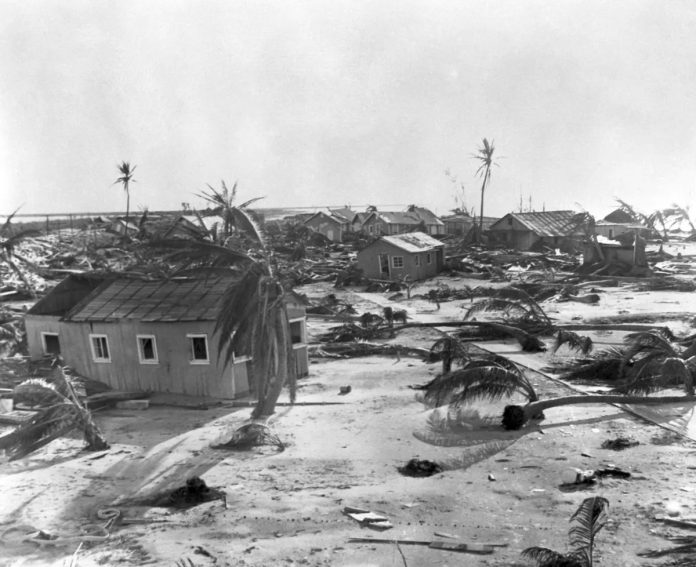‘Who Murdered the Vets?’ – 1935 US Labor Day Hurricane 90 years on
Scott Jones
Smoking cigarettes and having a drink cooling off after a long day’s work in the tropical sun back at camp, veterans building a highway to connect the Florida Keys to the mainland in September 1935 noticed the wind picking up, and heard reports of bad weather on its way. The next morning “not a blade of grass” remained.
The Labor Day Hurricane of 1935 was the most intense Atlantic hurricane on record, only broken over 50 years later, culminating in a devastating storm surge that swept all before it. Unfortunately, almost 700 workers, World War One veterans, were before it, with only “match-box wooden shacks” for shelter.
Among the first to turn up and aid with rescue and recovery, and to witness the horrific catastrophe, was writer Ernest Hemingway who lived in Key West and owned a fishing boat. He had also served and was wounded in World War One giving him a connection to these vets. Writing that same month in the socialist magazine New Masses, Hemingway hammers out on his typewriter his most impassioned and hard-hitting non-fiction work, “2,800 words of dynamite”, as he later called it.
Under the headline: “Who Murdered The Vets?” he contrasts the “wealthy people… such as President Hoover and President Roosevelt” who “do not come to the Florida Keys in hurricane months” because they know of the danger to their yachts and themselves, with the vets who had no choice and knew no better. Hemingway writes scathingly: “Veterans, especially the bonus-marching variety of veterans are not property. They are only human beings and all they have to lose are their lives.”
It was not until late the next day after the hurricane that any boat could get to Matecumbe Key where the camps were. What they found were hundreds of dead veterans in grotesque states and places. They had nowhere to shelter and nothing to stop them from being washed away. Hemingway said: “You found them everywhere and in the sun all of them were beginning to be too big for their blue jeans and jackets that they could never fill when they were on the bum and hungry… I would like to make whoever sent them there carry just one out through the mangroves.” Some of the surviving vets compared it to what they had seen during the war.
The veterans were there as part of President Franklin D Roosevelt’s New Deal program to get the unemployed back to work during the 1930s depression. But they had to campaign just to get that. In 1924 an act awarded bonuses to World War One veterans but not for 20 years, an insult at the time but a bearable one, given most had jobs. But by the early 1930s, many were out of work following the Wall Street Crash.
A so-called ‘Bonus Army’ numbering 43,000 marched on Washington DC in 1932 demanding the bonus now, but was brutally crushed by the US Army led by General Douglas MacArthur on the order of President Hoover. There was pressure on new president Roosevelt to act, he did so by sending the vets to work on projects like the Florida highway, seeing it as an opportunity to get them out of the way.
To give the scale of the tragedy, Hemingway says in Camp Five only eight out of 187 survived. Everyone knew when hurricane season was and there had been storm warnings and hurricane flags all over the Keys, meaning there was time to evacuate the vets. The subsequent investigation was a whitewash, completed just days afterwards and failing to call any witnesses.
A lack of concern for the victims of extreme climate events still remains and millions more every year are potential victims due to climate change. 90 years on we should remember who murdered the vets and fight to change the system that allowed it to happen.

